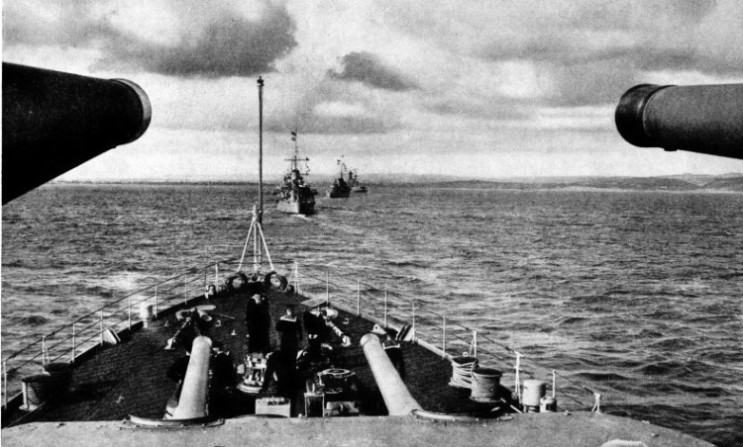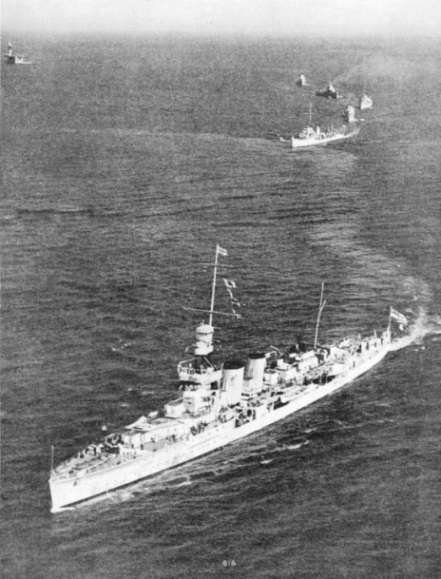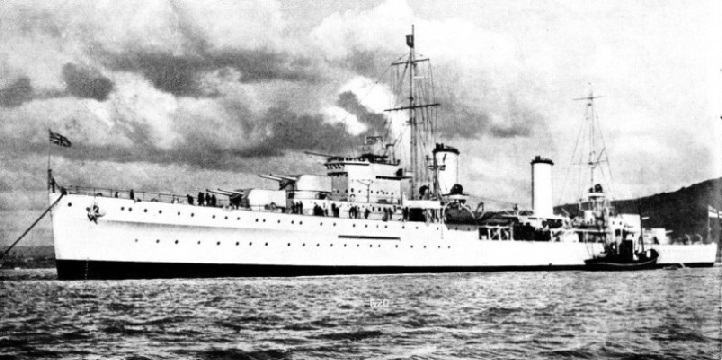

© Shipping Wonders of the World 2012-

Guarding the Seas
The cruisers of the Royal Navy patrol the trade routes of the British Empire, and guarantee the protection of merchant vessels in every ocean

CRUISERS on manoeuvres in the North Sea. This photograph was taken from H.M.S. Neptune, a cruiser of the Leander class, having a displacement of 7,030 tons. She was laid down in 1931 and completed in 1934. Her 72,000 horse-
NELSON and his admirals called insistently for the frigate class of warship. Equally urgent was the call for cruisers from Jellicoe and Beatty more than a century later. The modern cruiser is the lineal descendant of the old-
Just as there were heavy and light frigates in that era, so the cruisers in the modern British Fleet range from 10,000 tons to 4,200 tons displacement, with armaments varying from eight 8-
Since considerations of weight will not allow the use of heavy armour, the cruiser must rely for protection mainly on her speed. In the latest ships there is a patch of thin armour-
 The smaller type of cruiser is apt to be lively in a seaway and will ship a good deal of water when steaming at high speed; but there is nothing grander than to see such a vessel running her full-
The smaller type of cruiser is apt to be lively in a seaway and will ship a good deal of water when steaming at high speed; but there is nothing grander than to see such a vessel running her full-
COMBINED NAVAL EXERCISES. This picture shows H.M.S. Coventry leading destroyers during manoeuvres. Completed in 1918, H.M.S. Coventry is a cruiser of 4,290 tons. Her engines have a designed horsepower of 40,000, and give her a speed of 29 knots.
Even when the sea is calm a cruiser steaming at full speed is not on an even keel. Her bows lift up and the stern “sits down”, so that the quarterdeck becomes a tumbling mass of water. In such conditions life on board is not comfortable; but there is a certain thrill in the sense of tremendous power conveyed by the throb of the turbines underfoot and the roar in the funnels from the forced-
In time of peace British cruisers are formed into squadrons, and generally voyage and exercise in company. In the event of war most of the cruisers that are not attached to the battle fleets would be sent out to operate independently. That is why the command of a fine cruiser is the ambition of every naval officer of the younger school. Such a command gives the widest scope for initiative and the best opportunity of winning distinction.
The cruiser captain is sent to sea with sealed orders, which may direct him to proceed half-
There are about thirty-
Secret Destinations
Cruisers have their regular “beats”, which from time to time are visited by the “sergeant”, in the shape of the flagship. In fair weather and in foul, the lean, grey ships pass to and fro, spending so many days at sea, so many in harbour. Periodically they return to dockyard for rest, overhaul and a polish up before returning to duty. Occasionally the routes of patrols are varied so that an intending malefactor who had chosen a quiet spot for his depredations might get an unpleasant surprise. Only the Admiralty and the local Commander-
Apart from the battle-
A “County” class cruiser costs nearly £2,000,000 to build; an international treaty has placed a ban on the building of further vessels of this type. They are unduly large for ordinary cruiser duties, and too vulnerable to be used as battle cruisers.
“County” cruisers can be identified by their towering sides, which are almost as lofty as the freeboard of a liner. These cruisers have flush decks, three raking funnels of unequal girth, two slender pole masts, and big-

COMPLETED IN 1936, H.M.S. Apollo is one of the most modern cruisers in the British Navy. Her displacement (7,000 tons) is small compared with that of the cruisers of the “County” class. H.M.S. Apollo, H.M.S. Amphion and H.M.A.S. Sydney form the modified Leander class of cruiser. Their length between perpendiculars is 530 feet, and their 72,030 horse power geared turbines allow a maximum speed of 32½ knots.
These cruisers are propelled by geared turbines driving four shafts at a maximum speed of 32¼ knots. The machinery develops 80,000 horse-
The next largest type of cruiser is the Southampton class, consisting of H.M. Ships Southampton, Newcastle, Sheffield, Birmingham, Glasgow, Liverpool, Manchester and Gloucester. These were all laid down in 1934-
The British Admiralty considered that a ship of 7,000 tons was large enough for cruiser work, but as other nations were building cruisers of from 8,500 tons to 10,000 tons displacement, it was deemed necessary to restore the balance of power and lay down a group of big British cruisers. H.M.S. Southampton and her sisters are ships of 9,000 tons, with a designed sped of 32 knots and a main armament of twelve 6-
Nearer to the ideal type of cruiser, in the opinion of the Admiralty, are the eight ships of the Leander class, completed in 1933-
In the first five, H.M. Ships Leander, Neptune, Orion, Achilles and Ajax, the boiler rooms are close together and the uptakes lead into a single large funnel. The last three units, H.M.S. Amphion, H.M.S. Apollo and H.M.A.S. Sydney, have their boiler compartments more widely spaced and carry two funnels. All eight ships have proved successful, as steamers and as seaboats. On her trials H.M.S. Leander logged over 33 knots, though the engines were not forced. In 1934 H.M.S. Achilles steamed from Gibraltar to Plymouth, a distance of about 1,000 miles, at an average speed of 28½ knots. This was a record run for a man-
Between the 9,000-
The thirty-

A “COUNTY” CLASS CRUISER with a displacement of 9,750 tons. H.M.S. Devonshire was laid down in 1926 and completed in 1929. There are thirteen cruisers of this type in the British Navy; further construction has been banned by an international treaty. The cost of building a “County” class cruiser amounted to nearly £2,000,000. The 80,000 horse-
H.M.S. Emerald (7,550 tons) and H.M.S. Enterprise (7,580 tons) were laid down in 1918 and are the fastest cruisers in the Navy. In light condition they can make 33 knots. So heavy was the 80,000 horse -
The eight “D” class cruisers are much smaller, and displace only 4,850 tons. They were built for a speed of 29 knots. Six 6-
You can read more on “Battleships and Cruisers”, “Going to Sea” and “The Navy Goes to Work” on this website.